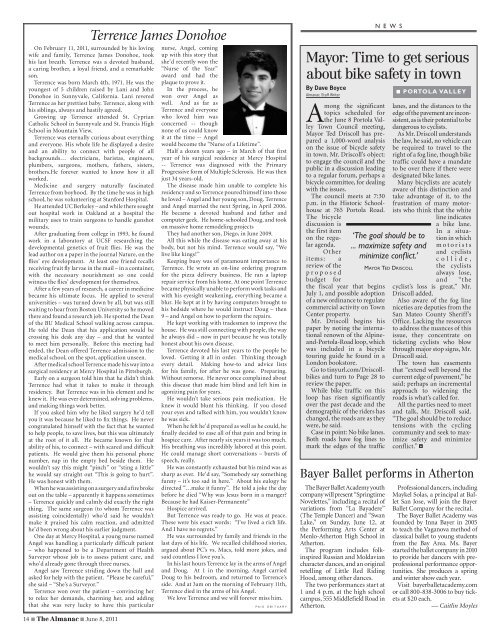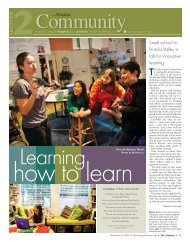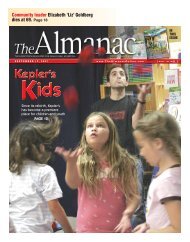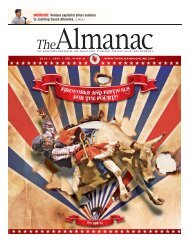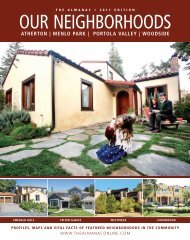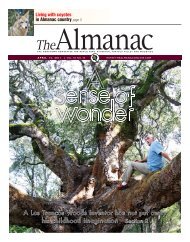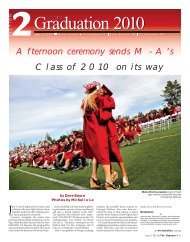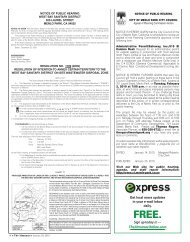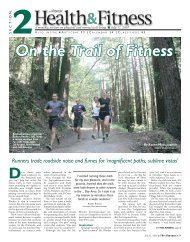You also want an ePaper? Increase the reach of your titles
YUMPU automatically turns print PDFs into web optimized ePapers that Google loves.
14 � The <strong>Almanac</strong> � June 8, 2011<br />
Terrence James Donohoe<br />
On February 11, 2011, surrounded by his loving<br />
wife and family, Terrence James Donohoe, took<br />
his last breath. Terrence was a devoted husband,<br />
a caring brother, a loyal friend, and a remarkable<br />
son.<br />
Terrence was born March 4th, 1971. He was the<br />
youngest of 5 children raised by Lani and John<br />
Donohoe in Sunnyvale, California. Lani revered<br />
Terrence as her prettiest baby. Terrence, along with<br />
his siblings, always and hastily agreed.<br />
Growing up Terrence attended St. Cyprian<br />
Catholic School in Sunnyvale and St. Francis High<br />
School in Mountain View.<br />
Terrence was eternally curious about everything<br />
and everyone. His whole life he displayed a desire<br />
and an ability to connect with people of all<br />
backgrounds… electricians, baristas, engineers,<br />
plumbers, surgeons, mothers, fathers, sisters,<br />
brothers.He forever wanted to know how it all<br />
worked.<br />
Medicine and surgery naturally fascinated<br />
Terrence from boyhood. By the time he was in high<br />
school, he was volunteering at Stanford Hospital.<br />
He attended UC Berkeley – and while there sought<br />
out hospital work in Oakland at a hospital the<br />
military uses to train surgeons to handle gunshot<br />
wounds.<br />
After graduating from college in 1993, he found<br />
work in a laboratory at UCSF researching the<br />
developmental genetics of fruit flies. He was the<br />
lead author on a paper in the journal Nature, on the<br />
flies’ eye development. At least one friend recalls<br />
receiving fruit fly larvae in the mail – in a container,<br />
with the necessary nourishment so one could<br />
witness the flies’ development for themselves.<br />
After a few years of research, a career in medicine<br />
became his ultimate focus. He applied to several<br />
universities – was turned down by all, but was still<br />
waiting to hear from Boston University so he moved<br />
there and found a research job. He spotted the Dean<br />
of the BU Medical School walking across campus.<br />
He told the Dean that his application would be<br />
crossing his desk any day – and that he wanted<br />
to meet him personally. Before this meeting had<br />
ended, the Dean offered Terrence admission to the<br />
medical school, on the spot, application unseen.<br />
After medical school Terrence made his way into a<br />
surgical residency at Mercy Hospital in Pittsburgh.<br />
Early on a surgeon told him that he didn’t think<br />
Terrence had what it takes to make it through<br />
residency. But Terrence was in his element and he<br />
knew it. He was ever determined, solving problems,<br />
and making things work better.<br />
If you asked him why he liked surgery he’d tell<br />
you it was because he liked to fix things. He never<br />
congratulated himself with the fact that he wanted<br />
to help people, to save lives, but this was ultimately<br />
at the root of it all. He became known for that<br />
ability of his, to connect – with scared and difficult<br />
patients. He would give them his personal phone<br />
number, nap in the empty bed beside them. He<br />
wouldn’t say this might “pinch” or “sting a little”<br />
he would say straight out “This is going to hurt”.<br />
He was honest with them.<br />
When he was assisting on a surgery and a fire broke<br />
out on the table – apparently it happens sometimes<br />
– Terrence quickly and calmly did exactly the right<br />
thing. The same surgeon (to whom Terrence was<br />
assisting coincidentally) who’d said he wouldn’t<br />
make it praised his calm reaction, and admitted<br />
he’d been wrong about his earlier judgment.<br />
One day at Mercy Hospital, a young nurse named<br />
Angel was handling a particularly difficult patient<br />
– who happened to be a Department of Health<br />
Surveyor whose job is to assess patient care, and<br />
who’d already gone through three nurses.<br />
Angel saw Terrence striding down the hall and<br />
asked for help with the patient. “Please be careful,”<br />
she said – “She’s a Surveyor.”<br />
Terrence won over the patient – convincing her<br />
to relax her demands, charming her, and adding<br />
that she was very lucky to have this particular<br />
nurse, Angel, coming<br />
up with this story that<br />
she’d recently won the<br />
“Nurse of the Year”<br />
award and had the<br />
plaque to prove it.<br />
In the process, he<br />
won over Angel as<br />
well. And as far as<br />
Terrence and everyone<br />
who loved him was<br />
concerned -- though<br />
none of us could know<br />
it at the time -- Angel<br />
would become the “Nurse of a Lifetime”.<br />
Half a dozen years ago – in March of that first<br />
year of his surgical residency at Mercy Hospital<br />
-- Terrence was diagnosed with the Primary<br />
Progressive form of Multiple Sclerosis. He was then<br />
just 34 years-old.<br />
The disease made him unable to complete his<br />
residency and so Terrence poured himself into those<br />
he loved – Angel and her young son, Doug. Terrence<br />
and Angel married the next Spring, in April 2006.<br />
He became a devoted husband and father and<br />
computer geek. He home-schooled Doug, and took<br />
on massive home remodeling projects<br />
They had another son, Diego, in June 2009.<br />
All this while the disease was eating away at his<br />
body, but not his mind. Terrence would say, “We<br />
live like kings!”<br />
Keeping busy was of paramount importance to<br />
Terrence. He wrote an on-line ordering program<br />
for the pizza delivery business. He ran a laptop<br />
repair service from his home. At one point Terrence<br />
became physically unable to perform work tasks and<br />
with his eyesight weakening, everything became a<br />
blur. He kept at it by having computers brought to<br />
his bedside where he would instruct Doug – then<br />
9 – and Angel on how to perform the repairs.<br />
He kept working with tradesmen to improve the<br />
house. He was still connecting with people, the way<br />
he always did – now in part because he was totally<br />
honest about his own disease.<br />
Terrence devoted his last years to the people he<br />
loved. Getting it all in order. Thinking through<br />
every detail. Making how-to and advice lists<br />
for his family, for after he was gone. Preparing.<br />
Without remorse. He never once complained about<br />
this disease that made him blind and left him in<br />
agonizing pain for years.<br />
He wouldn’t take serious pain medication. He<br />
knew it would blunt his thinking. If you closed<br />
your eyes and talked with him, you wouldn’t know<br />
he was sick.<br />
When he felt he’d prepared as well as he could, he<br />
finally decided to ease all of that pain and bring in<br />
hospice care. After nearly six years it was too much.<br />
His breathing was incredibly labored at this point.<br />
He could manage short conversations – bursts of<br />
speech, really.<br />
He was constantly exhausted but his mind was as<br />
sharp as ever. He’d say, “Somebody say something<br />
funny – it’s too sad in here.” About his eulogy he<br />
directed “…make it funny”. He told a joke the day<br />
before he died “Why was Jesus born in a manger?<br />
Because he had Kaiser-Permanente”<br />
Hospice arrived.<br />
But Terrence was ready to go. He was at peace.<br />
These were his exact words: “I’ve lived a rich life.<br />
And I have no regrets.”<br />
He was surrounded by family and friends in the<br />
last days of his life. We recalled childhood stories,<br />
argued about PC’s vs. Macs, told more jokes, and<br />
said countless I love you’s.<br />
In his last hours Terrence lay in the arms of Angel<br />
and Doug. At 1 in the morning, Angel carried<br />
Doug to his bedroom, and returned to Terrence’s<br />
side. And at 3am on the morning of February 11th,<br />
Terrence died in the arms of his Angel.<br />
We love Terrence and we will forever miss him.<br />
PAID OBITUARY<br />
By Dave Boyce<br />
<strong>Almanac</strong> Staff Writer<br />
Among the significant<br />
topics scheduled for<br />
the June 8 Portola Valley<br />
Town Council meeting,<br />
Mayor Ted Driscoll has prepared<br />
a 1,000-word analysis<br />
on the issue of bicycle safety<br />
in town. Mr. Driscoll’s object:<br />
to engage the council and the<br />
public in a discussion leading<br />
to a regular forum, perhaps a<br />
bicycle committee, for dealing<br />
with the issues.<br />
The council meets at 7:30<br />
p.m. in the Historic Schoolhouse<br />
at 765 Portola Road.<br />
The bicycle<br />
discussion is<br />
the first item<br />
on the regular<br />
agenda.<br />
Other<br />
items: a<br />
review of the<br />
proposed<br />
budget for<br />
the fiscal year that begins<br />
July 1, and possible adoption<br />
of a new ordinance to regulate<br />
commercial activity on Town<br />
Center property.<br />
Mr. Driscoll begins his<br />
paper by noting the international<br />
renown of the Alpineand-Portola-Road<br />
loop, which<br />
was included in a bicycle<br />
touring guide he found in a<br />
London bookstore.<br />
Go to tinyurl.com/Driscollbikes<br />
and turn to Page 28 to<br />
review the paper.<br />
While bike traffic on this<br />
loop has risen significantly<br />
over the past decade and the<br />
demographic of the riders has<br />
changed, the roads are as they<br />
were, he said.<br />
Case in point: No bike lanes.<br />
Both roads have fog lines to<br />
mark the edges of the traffic<br />
N E W S<br />
Mayor: Time to get serious<br />
about bike safety in town<br />
‘The goal should be to<br />
... maximize safety and<br />
minimize conflict.’<br />
MAYOR TED DRISCOLL<br />
� PORTOLA VALLEY<br />
lanes, and the distances to the<br />
edge of the pavement are inconsistent,<br />
as is their potential to be<br />
dangerous to cyclists.<br />
As Mr. Driscoll understands<br />
the law, he said, no vehicle can<br />
be required to travel to the<br />
right of a fog line, though bike<br />
traffic could have a mandate<br />
to be over there if there were<br />
designated bike lanes.<br />
Many bicyclists are acutely<br />
aware of this distinction and<br />
take advantage of it, to the<br />
frustration of many motorists<br />
who think that the white<br />
line indicates<br />
a bike lane.<br />
In a situation<br />
in which<br />
motorists<br />
and cyclists<br />
collide,<br />
the cyclists<br />
always lose,<br />
and “the<br />
cyclist’s loss is great,” Mr.<br />
Driscoll added.<br />
Also aware of the fog line<br />
niceties are deputies from the<br />
San Mateo County Sheriff’s<br />
Office. Lacking the resources<br />
to address the nuances of this<br />
issue, they concentrate on<br />
ticketing cyclists who blow<br />
through major stop signs, Mr.<br />
Driscoll said.<br />
The town has easements<br />
that “extend well beyond the<br />
current edge of pavement,” he<br />
said; perhaps an incremental<br />
approach to widening the<br />
roads is what’s called for.<br />
All the parties need to meet<br />
and talk, Mr. Driscoll said.<br />
“The goal should be to reduce<br />
tensions with the cycling<br />
community and seek to maximize<br />
safety and minimize<br />
conflict.” A<br />
Bayer Ballet performs in Atherton<br />
The Bayer Ballet Academy youth<br />
company will present “Springtime<br />
Novelettes,” including a recital of<br />
variations from “La Bayadere”<br />
(The Temple Dancer) and “Swan<br />
Lake,” on Sunday, June 12, at<br />
the Performing Arts Center at<br />
Menlo-Atherton High School in<br />
Atherton.<br />
The program includes folkinspired<br />
Russian and Moldavian<br />
character dances, and an original<br />
retelling of Little Red Riding<br />
Hood, among other dances.<br />
The two performances start at<br />
1 and 4 p.m. at the high school<br />
campus, 555 Middlefield Road in<br />
Atherton.<br />
Professional dancers, including<br />
Maykel Solas, a principal at Ballet<br />
San Jose, will join the Bayer<br />
Ballet Company for the recital.<br />
The Bayer Ballet Academy was<br />
founded by Inna Bayer in 2005<br />
to teach the Vaganova method of<br />
classical ballet to young students<br />
from the Bay Area. Ms. Bayer<br />
started the ballet company in 2010<br />
to provide her dancers with preprofessional<br />
performance opportunities.<br />
She produces a spring<br />
and winter show each year.<br />
Visit bayerballetacademy.com<br />
or call 800-838-3006 to buy tickets<br />
at $20 each.<br />
— Caitlin Moyles


